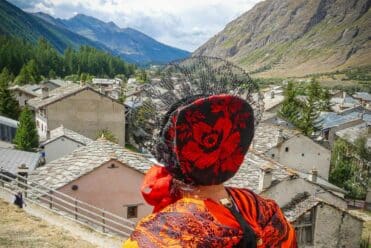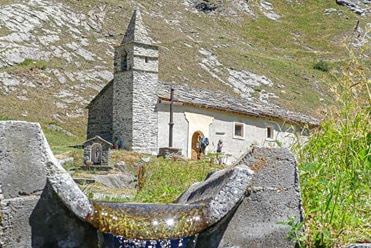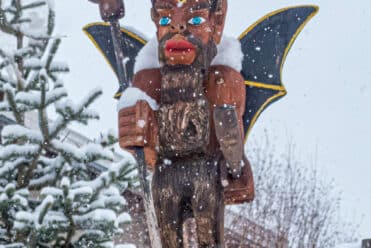Over two centuries of history
At Christmas, Bessanais sing this verse in a large living crib depicting the birth of Jesus. A verse that is only a small part of a patois Christmas carol written in Haute Maurienne over two centuries ago.
The tradition of Christmas carols dates back to the 16th century, when the famous "mysteries" were banned in Paris. These large-scale plays, often lasting several days, depicted scenes from the Bible. These mysteries provided a clear and simple way of teaching the Catholic religion. After they were banned, the songs took over this function. Some songs were even mimed.
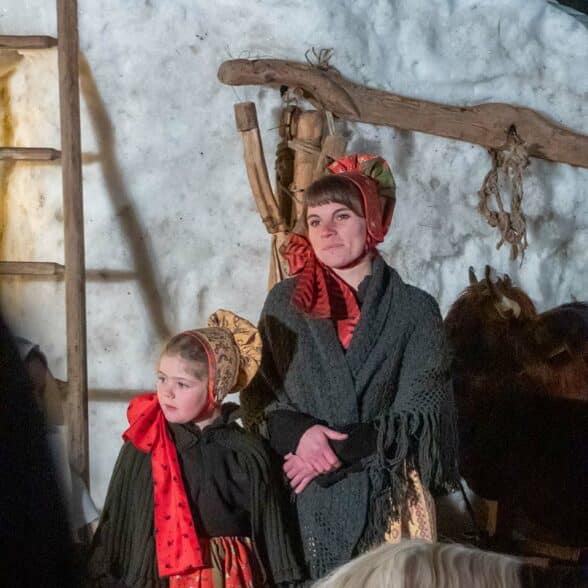
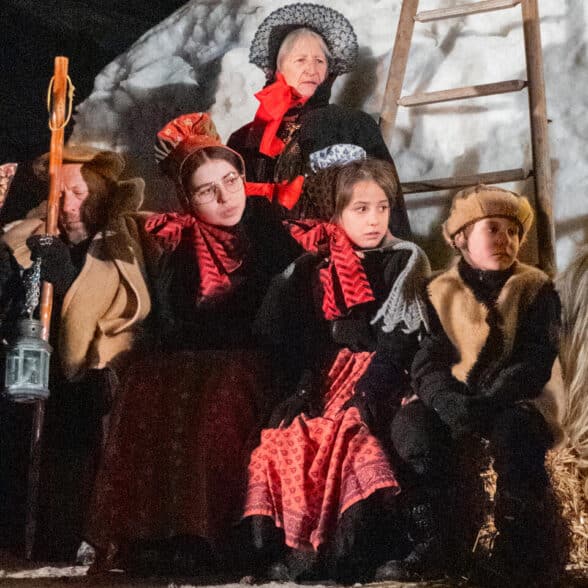
Christmas carols from Bessans
An ancestral heritage... alive and well!"Christmas carols in dialect exist all over Occitanie and Rhône-Alpes. But Bessans holds a special place in the world of traditional song. Local carols are plentiful, and we're lucky enough to have recordings made nearly half a century ago by a couple visiting the village. For example, we have a rare Savoyard polyphonic credo," assures Péroline Barbet, researcher at the Villeurbanne-based Centre des Musiques Traditionnelles Rhône-Alpes.
The richness of Bessans' oral heritage has long been recognized. At the end of the 19th century, Julien Tiersot, an envoy from the Ministry of Public Instruction, came to Savoie to collect sacred and secular songs. His visit to Bessans made a particular impression on him, even if he did encounter a few difficulties before being granted a concert: "I remember in particular a tall girl who had been designated as having the most beautiful voice in the country, and with whom negotiations were particularly difficult. In truth, she began by rejecting my request with as much indignation as if I had spoken dishonest words to her! What's more, I was playing with misfortune: on the appointed day, a singer who had given me his word was arrested by the gendarmes for smuggling. An ordinary adventure, but one which, whenever it happens, nonetheless gives the population a momentary cause for concern.
Folk art treasures
Songs transcribed from 19th-century manuscriptsIn the end, the people of Bessans sang for Julien Tiersot. The "big girl" even performed for him "Christmas tunes from Bessans, which she intoned with a bugle voice capable of making echoes reverberate from Mont Cenis to the Vanoise".
In addition, the Ministry's envoy was able to consult "four notebooks, one of which is a collection of Christmas manuscripts with dates ranging from 1820 to 1855 (...) A second, more modern notebook contains no less than one hundred and two song texts.
These notebooks are veritable folk art treasures. These manuscripts were handed down from generation to generation until the 1970s. The pages are embellished with beautiful color illustrations depicting the nativity, nativity scenes, the baptism of Jesus... Flowers, foliage and vases enhance the calligraphy. Village illuminations show the care taken with the booklets, and underline the artistic skill of the Bessan people.

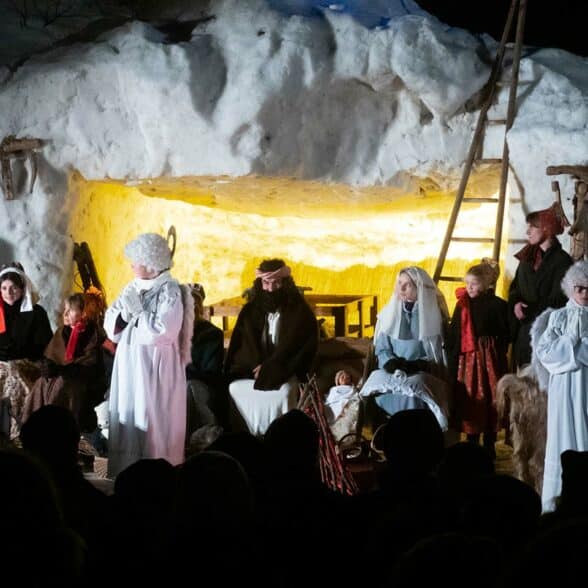
The baby Jesus is said to have been born in Bessans...
... or l'Esseillon?In the book "Bessans, ouvrage d'art", author Suzanne Bourgeois retraces the history of some of these manuscripts. These notebooks date from the 19th century. They were written by hand, with new songs and hymns added year after year. The notes and music are regularly indicated, but sometimes there's just the text. The tune to which these texts were to be sung was transmitted orally.
When the songs ceased to be sung, the air was gradually lost. Some of these songs may have been brought by priests from France or by peddlers. But some were composed on the spot, as evidenced by the many references to local geography and traditions. In these local songs in patois, the baby Jesus is honored by the villagers, who bring him gifts that are typically Maurienne: cheese, butter, lamb, game... In fact, according to these songs, the baby Jesus was not born in Bethlehem, as the official story goes, but right here! Even if the exact place changes according to the songs: in "la grange du Carrelay" (le Carrelet in Bessans itself), at the forts of l'Esseillon (between Aussois and Avrieux) or a little further away, near Belley...
Some fifty different songs
French and patois songs for the whole holiday seasonIn her book "Bessans chante Noël, chants sacrés, chansons profanes", Jeanne Ratel lists no fewer than 51 different songs, 44 in French and 6 in the "Bessans language". If there are so many texts, it's because they're not all intended to be sung on December 24 and 25. In fact, the songs cover the entire Christmas season.
There are songs for the various Christmas masses (midnight mass, dawn mass and day mass), then for all the religious feasts that follow the birth of Jesus: songs in honor of Saint Stephen, Saint John the Evangelist, for the circumcision of Christ (on the eighth day after birth, as required by the Jewish religion), for the Three Kings...
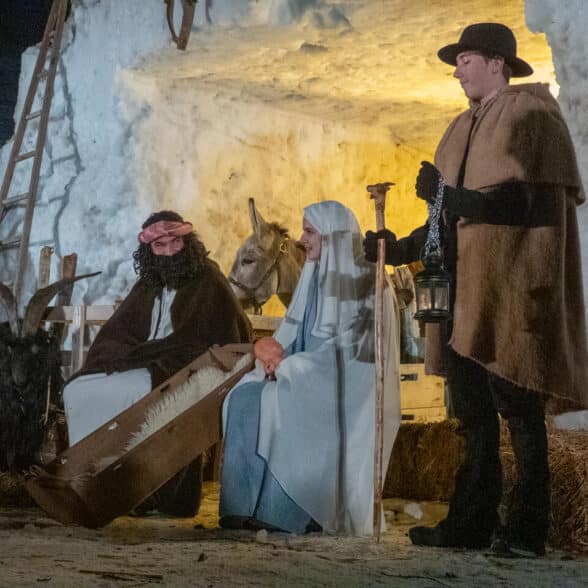
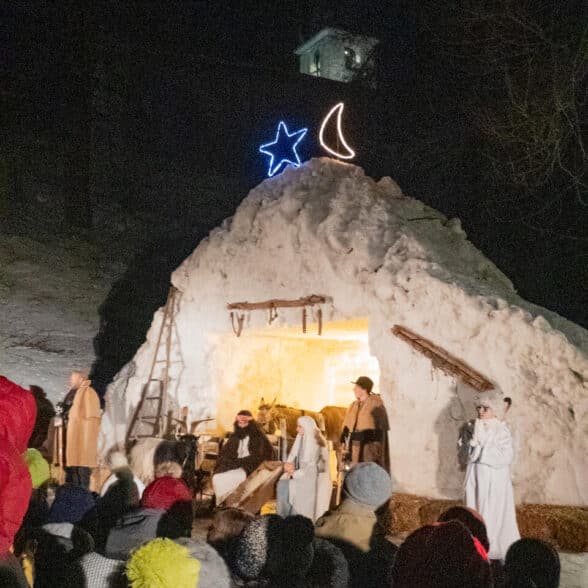
Living creche
A real show for ChristmasThese traditional songs are still used during the festive season. And especially during the annual living nativity scene, when Bessanais gather to sing "Dzens qu'èthes din vothres misons, attapis quème de marmottes, ne tsauchez pas vothros sapons, prenez selamint vothres socques. Sortez, defau est tzauza ethrandze, o zi varrea los andzes, que baillont a tuit lo bonzom." One of the many songs sung at the living nativity scene organized every year at Christmas. A crib with a snow grotto as stable guide and dozens of participants in traditional Bessans garb. It's a real spectacle, revealing to spectators that, according to local tradition, Jesus was born here.

